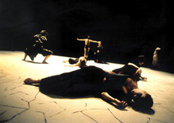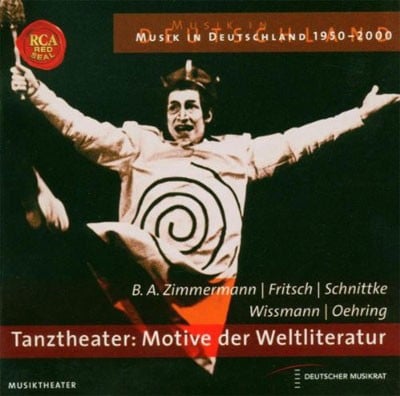OPERA SEARCH

Bernarda Albas Haus (with Helmut Oehring)
(The House of Bernarda Alba) (1999)Based on the play by Federico García Lorca
deaf soloist (female), soprano (male); 7 dancers;
elec.gtr-db-live electronics
Abbreviations (PDF)
Bote & Bock
Basel
Joachim Schlömer, choreographer
Company: Theater Basel
‘A piece about silence.’ That is the theme Joachim Schlömer and Helmut Oehring have chosen for The House of Bernarda Alba. Federico García Lorca’s story of old Bernarda and her daughters is re-told through dance. The Spanish village tragedy is not in the foreground, however, but the effects and principles of prohibitions and taboos. What is the life of seven women in a house like in which the subject of sexuality is a taboo? Helmut Oehring’s music provides a musical space for this ‘tragedy’ by making visible the ‘oppressive atmosphere of silence’ by an impressive compositional condensation of electronically alienated sounds.
"The company that performed Bernarda in Basle goes further in terms of abstraction than all others who have attempted to translate this play into dance. The fable is interesting only in that it creates a hysterical atmosphere which is intended by Schlömer and Oehring: a pressure cooker of suppressed passions, in danger of exploding almost from the start.
The music is involved in the creation of this atmosphere more actively than with most of the other dance pieces... an unconventional form of music consisting of melodically interpolated noises: sung cantilenas soaring over clusters, nervous sawing of the double bass, electronic explosions behind which, almost inaudibly, Schubert’s Ave Maria or the distant singing of a muezzin unfolds...
For an hour and fifteen minutes the performance works itself into the nervous centre of the audience." (Jochen Schmidt, FAZ, 19.11.1999)
"The three authors are apparently of like minds and perceptions, thus the resulting dance theatre piece is amazingly coherent. Helmut Oehring and Iris ter Schiphorst wrote a score that reciprocates between extreme states of slow-motion leading to standstill on the one hand and musical congealment in piercing noise on the other. Monotonous repetitions, fractures, new starts of the same ideas, loops, some isolated sounds from outside (bells, a bird) and time and again fragments from Bach and Schubert – memories of the past, of a perfect world, a sense of yearning lost in the noise of an age-old grammophone. To Lorca’s characters, Oehring and ter Schiphorst added a peculiar couple, whose function resembles that of the evangelist in Bach’s Passions. In reality, though, the two added characters personify the impossibility of telling a story which is actually set in the world of emotions. One of them is the deaf actress Christina Schönfeld, who recounts the basic story of Bernarda Alba and her daughters in sign language, the other is countertenor Arno Raunig, whose text is naturally incomprehensible, as it is sung in cantilena style, and who literally fills the main characters’ fate with expression. Throughout the whole work the couple seems strangely unwieldy, also in the musical context, because – though doing what you would expect them to do – they are ultimately impossible to understand.
On the basis of this score, Joachim Schlömer produced a choreography for the ensemble of the Basel dance theatre company which was characterised by realistic symbolism, featuring the stage and dress colours (or non-colours) black/white and occasionally red (Frank Leimbach, Gesine Völlm). The only ‘real’ dance is a fatal flamenco. Like the music, the dancing style is dominated by discontinuous, fragmentary elements: disturbances, random activism, eruptions leading to nothing. Only Bernarda Alba, with her slow gait and movements, represents frightening steadiness. In all the premieres, music and dance merged to a black emotional theatre consisting of gesture, movement and sound, uncompromising, unvarnished, brutal, but moving. The dancers of the Basel dance theatre company and the musicians Peter Kowald (double bass), Markus Retschnefki (prepared piano, keyboard) and Jörg Wilkendorf (electric guitar) gave definition to dance and sound. And at last I got hold of a seat in the Hebbel Theatre, to experience the necessity of the Dolby surround acoustics (Torsten Ottersberg)." (Giesela Nauck, Positionen, February 2000)
Tragic

Arno Raunig / Christina Schönfeld / Jörg Wilkendorf / Peter Kowald / Markus Reschtnewki u.a.
(Deutscher Musikrat - Musik in Deutschland 1950-2000 / Tanztheater / Motive der Weltliteratur)
BMG 74321 73577 2
